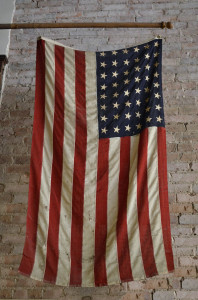June 14 – A Day of Commemoration
 Are you ready to display Old Glory this month? Check your calendar and you’ll see Flag Day noted on June 14. Our national flag’s birthday, tucked between Memorial Day and Independence Day, doesn’t seem to ignite much patriotism among Americans these days. Perhaps it’s because Flag Day is not a federal holiday or maybe Americans just don’t understand the historical significance.
Are you ready to display Old Glory this month? Check your calendar and you’ll see Flag Day noted on June 14. Our national flag’s birthday, tucked between Memorial Day and Independence Day, doesn’t seem to ignite much patriotism among Americans these days. Perhaps it’s because Flag Day is not a federal holiday or maybe Americans just don’t understand the historical significance.
During the American Revolutionary War, colonists fought under unit or regimental flags. Realizing a need for conformity, the Second Continental Congress took the responsibility of making the change. It was on June 14, 1777, while meeting in Philadelphia to draft the Articles of Confederation, that the Second Continental Congress proclaimed a specific design for the Union’s flag—the purpose being that each of the naval vessels of the United States Continental Army would be recognized collectively as representing the United States. Taken from the original proclamation: “Resolved, That the flag of the thirteen United States be thirteen stripes, alternate red and white; that the union be thirteen stars, white in a blue field, representing a new constellation.”
Flying of the flag by individuals didn’t become popular until the Civil War in 1861. Numerous patriotic citizens and elected officials advocated June 14 for observance of the U.S. flag, but it was Bernard J. Cigrand who was dubbed the “Father of Flag Day.” In 1885, Cigrand, a 19-year-old teacher at Stony Hill School, Waubeka, Wisconsin, placed a 10 inch, 38- star flag in a bottle on his desk then assigned essays on the flag and its significance, leading students in the first formal observance of the flag. In June, 1886, he moved to Chicago and publicly proposed an annual observance of the United States flag in an article titled “The Fourteenth of June,” published in the Chicago Argus newspaper. In June 1888, Cigrand advocated the same in a speech before the “Sons of America,” an organization that founded American Standard Magazine. Cigrand was appointed editor-in-chief and used his position for promoting patriotism and the flag. He later became president of the American Flag Day Association and the National Flag Day Society.
Finally, in 1916, President Woodrow Wilson issued a proclamation officially establishing a nationwide observance of Flag Day on June 14. On August 3, 1949, President Harry S. Truman signed legislation designating June 14 as National Flag Day. The week of June 14 is now designated as “National Flag Week” when the president issues a proclamation urging us to fly the American flag on our homes, businesses, and all government buildings. Some cities, towns, and organizations hold parades, carnivals, fireworks and other events. The National Flag Day Foundation holds an annual observance for Flag Day on the second Sunday in June at its Americanism Center in Waubeka, Wisconsin.
So get out the iconic Old Glory and hang it proudly. National Flag Day is a way to collectively tell the world that our national flag unites our 50 states—one Nation, under God, with Liberty and Justice for all!




